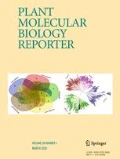Abstract
It is increasingly important to understand a gene’s function at the protein level. Immunohistochemistry is used to identify new functions of phytohormones by finding their precise localization patterns. To facilitate protein immunolocalization, we developed a protocol that can significantly reduce background and give highly specific signals of antibody to traget proteins. The key improvement is to treat secondary antibodies by mixing with homogenized fresh and fixed plant tissue. Using this protocol, we have successfully carried out immunolocalization of proteins encoded by genesAP3 andHoMADS2, as well as plant hormones ABA and IAA.
Similar content being viewed by others
Abbreviations
- AP3:
-
apatala 3
- AP:
-
alkaline phosphatase
- BS:
-
blocking solution
- BSA:
-
bovine serum albumin
- EDC:
-
1-(3-dimethylaminoprapyl)-3-ethyl carbodiimide
- FAA:
-
formaldehydeacetic acid medium
- HWB:
-
high-salt washing buffer
- LWB:
-
low-salt washing buffer
- PBS:
-
phosphate-buffered saline
- PI:
-
pistallata
References
Ausubel FM, Brent R, Kingston RE, Moore DD, Seidman JG, Smith JA, and Struhl K (eds) (1999) Short Protocols in Molecular Biology, John Wiley & Sons, New York.
Benkova E, Michniewicz M, Sauer M, Teichmann T, Seifertova D, Jurgens G, and Friml J (2003) Local, efflux-dependent auxin gradients as a common module for plant organ formation. Cell 115: 591–602.
Caruso JL, Pence VC, and Leverone LA (1995) Immunoassay methods of plant hormone analysis. In: Davies PJ, ed. Plant Hormones: Physiology, Biochemistry and Molecular Biology, Kluwer Academic Publishers, Dordrecht, Netherlands.
Dewitte W, Chiappetta A, Azmi A, Witters E, Strnad M, Rembur J, Noin M, Chriqui D, and Van Onckelen H (1999) Dynamics of cytokinins in apical shoot meristems of a day-neutral tobacco during floral transition and flower formation. Plant Physiol 119: 111–122.
Engler JA, Montagu MV, and Engler G (1994) Hybridization in situ of whole-mount messenger RNA in plants. Plant Mol Biol Rep 12: 321–331.
Friml J, Vieten A, Sauer M, Weijers D, Schwarz H, Hamann T, Offringa R, and Jurgens G (2003) Efflux-dependent auxin gradients establish the apical-basal axis ofArabidopsis. Nature 426: 147–153.
Goto, K and Meyerowitz EM (1994) Function and regulation of theArabidopsis floral homeotic gene PISTILLATA. Genes Dev 8: 1548–1560.
Kim JY, Yuan Z, and Jackson D (2003) Development regulation and significance of KNOX protein trafficking inArabidopsis. Development 130: 4351–4362.
Lucas WJ, Bouche-Pillon S, Jackson DP, Nguyen L, Baker L, Ding B, and Hake S (1995) Selective trafficking of KNOTTEDI and its mRNA through plant plasmodesmata. Science 270: 1980–1983.
Maliga P, Klessig DF, Cashmore AR, Gruissem W, and Varner JE (1995) Methods in Plant Molecular Biology: A Laboratory Course Manual. Cold Spring Harbor, New York, Cold Spring Harbor Laboratory Press.
Moctezuma E (1999) Changes in auxin patterns in developing gynophores of the peanut plant (Arachis hypogaea L). Ann Bot 83: 235–242.
Muller A, Guan C, Galweiler T, Tanzler P, Huijser P, Marchant A, Parry G, Bennett M, Wisman E, and Palme K (1998) AtPIN2 defines a locus ofArabidopsis for root gravitropism control. EMBO J 17: 6903–6911.
Nakayama A, Park S, Xu ZJ, Nakajima M, and Yamaguchi I (2002) Immunohistochemistry of active gibberellins and gibberellin-inducible α-analase in developing seeds of morning glory. Plant Physiol 129: 1045–1053
Reinhardt D, Pesce ER, Stieger P, Mandel T, Baltensperger K, Bennett M, Traas J, Firml J, and Kuhlemeier C (2003) Regulation of phyllotaxis by polar auxin transport. Nature 426: 255–260.
Schrautl D, Ullrich CI, and Hartung W (2004) Lateral ABA transport in maize roots (Zea mays): visualization by immunolocalization. J Exp Bot 55: 1635–1641.
Su HY, Li QZ, Li XG, and Zhang XS (2005) Characterization and expression analysis of a MADS box gene, HoMADS2, inHyacinthus orientalis L. Acta Genet Sin 32: 1191–1198.
Wang DH, Han T, Gong HQ, Zhang L, and Bai SN (2004) A simple method for protein recovery with ordinary electrophoresis apparatus. Plant Physiol Commun 40: 75–77.
Zavala ME and Brandon DL (1983) Localization of a phytohormone using immunocytochemistry. J Cell Biol 97: 1235–1239.
Author information
Authors and Affiliations
Corresponding author
Additional information
These authors contributed equally
Rights and permissions
About this article
Cite this article
Gong, HQ., Peng, YB., Zou, C. et al. A simple treatment to significantly increase signal specificity in immunohistochemistry. Plant Mol Biol Rep 24, 93–101 (2006). https://doi.org/10.1007/BF02914049
Issue Date:
DOI: https://doi.org/10.1007/BF02914049



